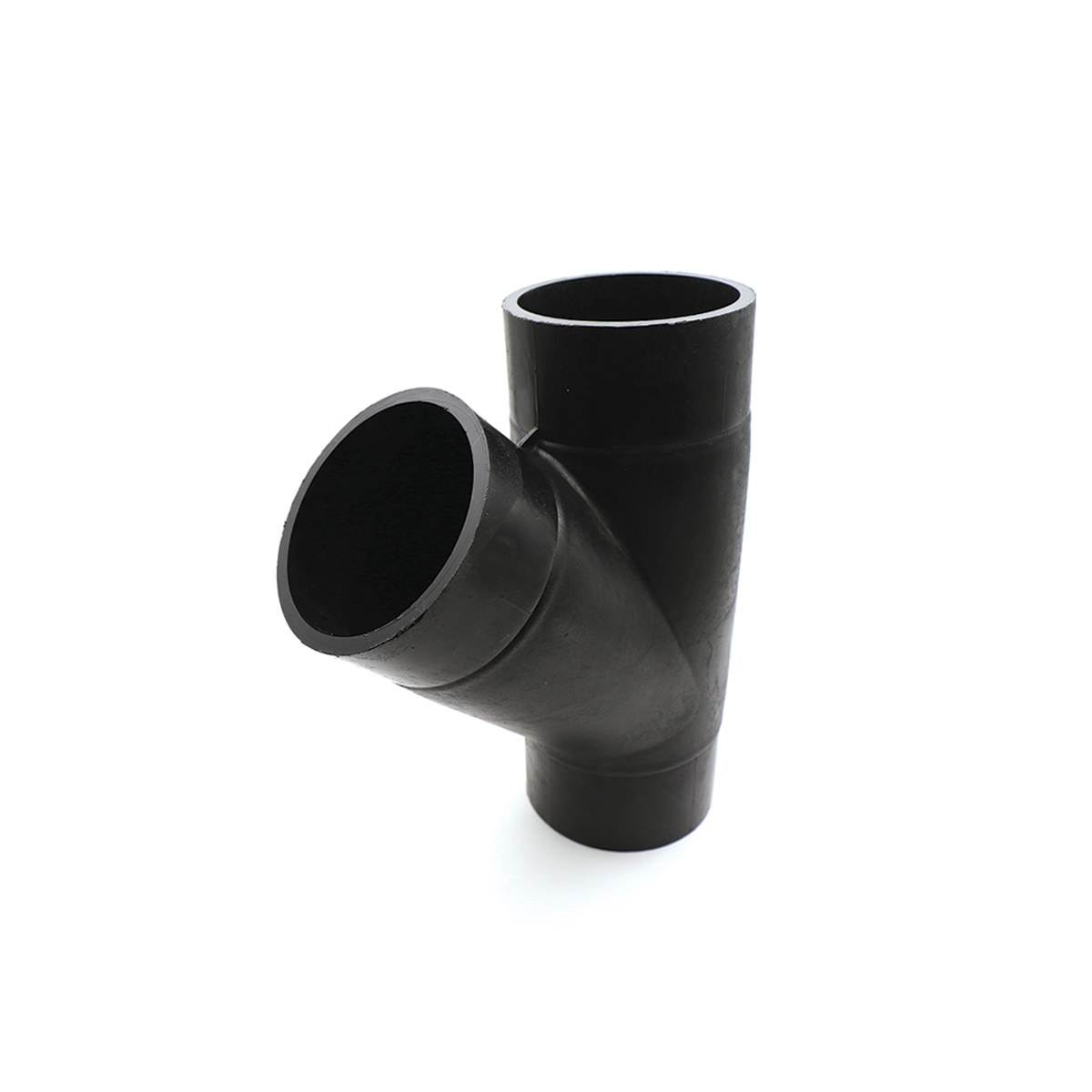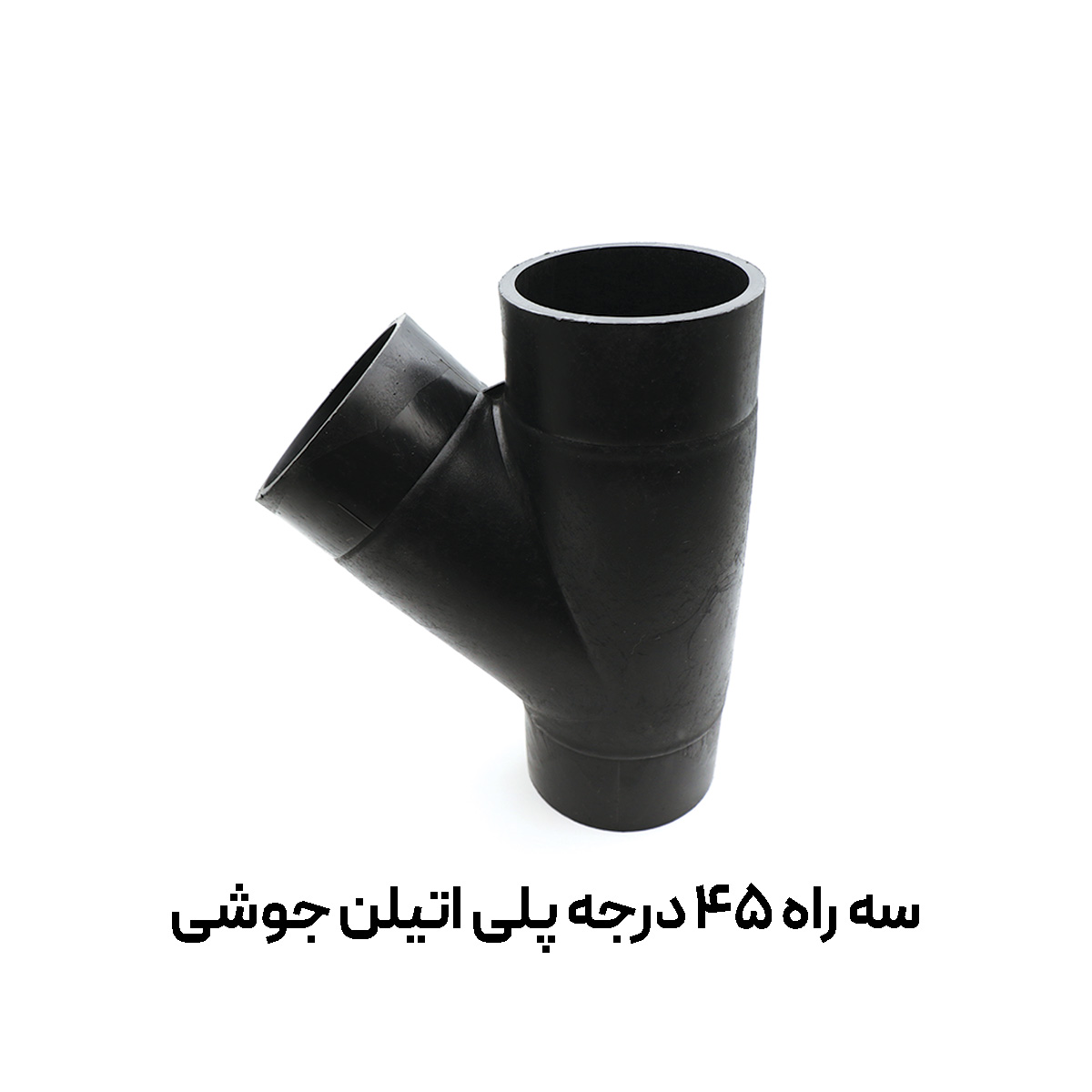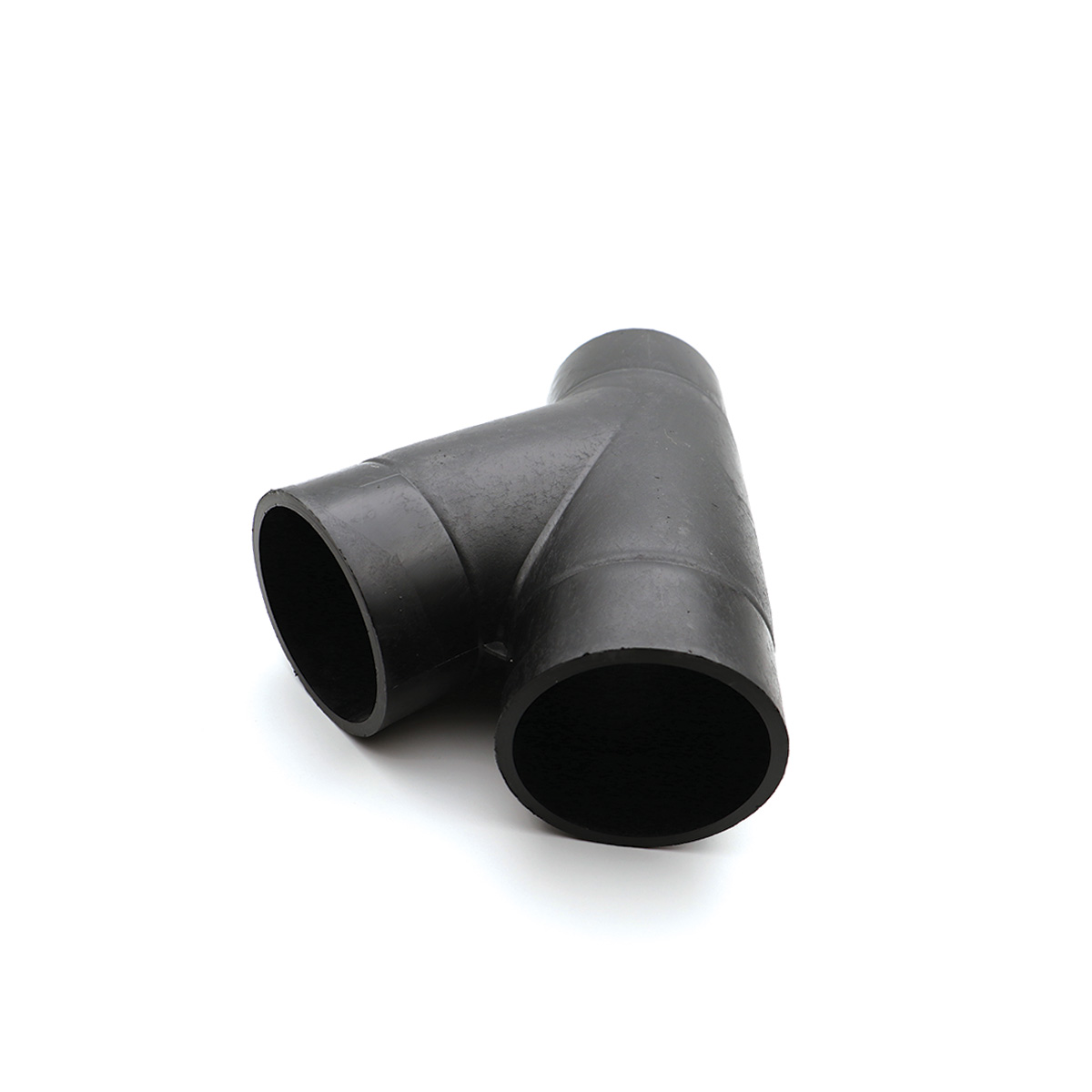45° HDPE butt-fusion wye fitting (Y-fitting) is a connector for smooth, low-loss branching from a pipeline. The 45-degree angle lets flow in the branch move with minimal turbulence, reducing deposition. This part is manufactured from PE100 or PE80 grades and is a reliable option for water supply lines, gravity sewage, drainage, and pressurized irrigation.
Introduction & Structure
The 45° butt-fusion polyethylene wye consists of three aligned ends, with the branch end connected to the main body at a 45° angle. Each of the three ends is typically joined to the pipe by butt fusion, and thanks to material homogeneity, a monolithic joint with strength close to that of the pipe itself is formed.
Advantages & Strengths
- Lower pressure drop compared to 90° tees and standard tees
- Excellent resistance to impact, abrasion, and corrosive media
- Lightweight and easy to transport in various sizes
- Smooth internal surface and low roughness for better fluid passage
- Complete leak-tightness due to homogeneous welding, with no consumable gaskets needed
- High durability in humid and buried environments
Applications
- Branching from trunk mains in urban and rural water-supply networks
- Transmission lines for raw water, treated effluent, and gravity sewage
- Drip and sprinkler irrigation networks and bypass routes in farms and orchards
- Discharge and collection of stormwater and drains in civil and industrial projects
Key Technical Specifications
| Feature | Description |
|---|---|
| Body material | Polyethylene grade PE100 or PE80 |
| Jointing method | Butt fusion (Butt Fusion) |
| Branch angle | 45 degrees |
| Common size range | 63 to 400 mm (and larger on request) |
| Common pressure rating | PN6.3 to PN16, depending on SDR |
| Color & marking | Black body, colored stripes according to project application |
| Reference standards for pipe/fittings | Based on common HDPE pipe standards such as relevant ISO and DIN |
Sizing & Pressure Selection Guide
Selection of the wye should be based on design pressure, fluid temperature, required flow rate, and SDR class. The smaller the SDR, the thicker the wall and the higher the pressure capacity. In water-supply networks, SDR11 or SDR13.6 is typically used for trunk mains, and SDR17 and above for lower-pressure lines.
Sizing Table & Suggested Pressure Class
Sizing table for “45° polyethylene wye (Y)” (actual Z and L dimensions and thickness e) based on the PE100 product catalog. The figures below are for PN16 (SDR11); for PN10 (SDR17) the Z and L lengths remain the same, and only thickness and weight decrease.
Standard Dimension Table – 45° Polyethylene Wye (PE100) – PN16 (SDR11)
| d (mm) | Z (mm) | L (mm) | e (thickness, mm) | Approx. weight (kg) |
|---|---|---|---|---|
| 63 | 164 | 254 | 5.8 | 0.474 |
| 75 | 185 | 284 | 6.8 | 0.693 |
| 90 | 213 | 321 | 8.2 | 1.150 |
| 110 | 230 | 390 | 10.0 | 1.968 |
| 125 | 277 | 412 | 11.4 | 2.860 |
| 160 | 300 | 503 | 14.6 | 5.225 |
| 180 | 394 | 578 | 16.4 | 8.590 |
| 200 | 430 | 630 | 18.2 | 11.350 |
| 225 | 475 | 692 | 22.7 | 15.790 |
| 250 | 507 | 729 | 25.4 | 20.130 |
Additional Notes for Pressure
- Note: For sizes above 250 (e.g., 315/355/400) the part is generally “mitered/custom-made,” and dimensions depend on the manufacturer.
- Note: The final selection of SDR and PN must align with hydraulic calculations and project conditions (operating temperature, buried or above-ground installation, etc.).
- PN10 (SDR17) note: For the same sizes, Z and L do not change; sample thickness/weight: 63 → e=3.8, 0.342 kg; 75 → 4.5, 0.502 kg; 90 → 5.4, 0.840 kg; 110 → 6.6, 1.526 kg; … up to 250 → 14.8, 14.84 kg. Source: same catalog above.
- For PE100 at 20°C, the standard SDR↔PN mapping is: SDR11 → PN16, SDR13.6 → PN12.5, SDR17 → PN10, SDR21 → PN8, SDR26 → PN6.3 (per ISO 4427). If pressure rows are also present on the page, the above figures are the correct reference.
Design Notes for Better Performance
- In high-flow routes, using a 45° wye instead of a 90° tee reduces turbulence and cavitation.
- To prevent deposition, keep branch flow velocities within recommended design ranges.
- Provide proper supports and restraints at direction changes to absorb hydraulic and thermal forces.
- If there is a size difference between the main and the branch, use a standard reducer before the wye.
Butt Fusion Welding Instructions (Butt Fusion)
- Square cutting & preparation: Cut pipe ends and wye ports perfectly perpendicular to the axis; plane with a facing tool to remove oxidation and contamination.
- Alignment & clamping: Place parts in the machine jaws and align; ovality or gaps between ends should be negligible.
- Heating: Use a clean, properly heated plate; ensure uniform contact of ends with the plate until a uniform melt bead forms.
- Pressurizing & cooling: After removing the heater plate, press the ends together with controlled force and hold clamped until fully cooled.
- Weld quality control: Uniform bead, no burning, voids, or misalignment, and perform a hydrostatic test according to the project procedure.
Quality Control & Tests
- Visual inspection of the weld bead and uniformity in a clean environment
- Hydrostatic pressure testing of the line after installation
- Verification of raw-material certificates (grade, MFR, long-term strength)
- Production traceability and marking of size, SDR, and production date on the body
Storage & Handling
- Store parts in shade, away from direct sunlight and high temperatures.
- Avoid severe impacts during transport, and keep joint surfaces free from contamination and dust.
- Before welding, ensure the ends are dry and free of oils or fine particles.
You can procure the desired 45° butt-fusion polyethylene wye from specialized pipe and fitting suppliers. Tamam Baha is one of the sellers of this product and, for customers in the Middle East and beyond, provides technical consultation, stock checks, and current pricing and can coordinate shipping; naturally, other vendors also offer this item, and the supplier should be chosen based on project needs and after-sales service.



